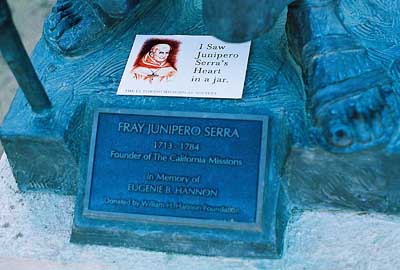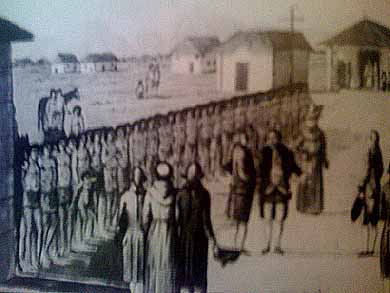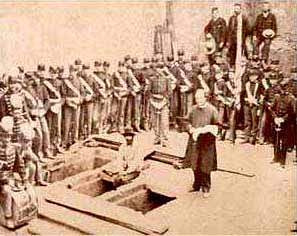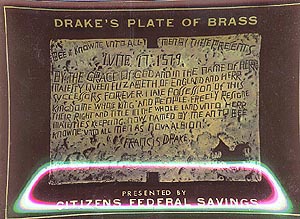|

“Junipero
Serra founded the California mission system.
His statues are all over California.
He has streets named after him. His image is on prayer cards
and hundreds of shirts sold in the gift shop at the El Fornio Historical
Society
—that should be enough.
Listen
to voice over artist Tim George

read
the part of Hank Peabody
Visit
Tim George's website to learn more
about his work
www.timgeorgevo.com
Hank Comes to Grips with Serra
from The Reeducation of a Turd Peddler
by John Henry Peabody
“The destruction of a way of life in a foreign land is the
curriculum vitae for canonization? Self-flaggelation and denial of
corporal pleasure by cutting and burning of one’s own flesh with
blade and wax is a prerequisite to sainthood?
I’m going to quote Robert Plant again, `I don’t th’ANK
so!”
— Hank Peabody
Director & Curator
The El Fornio Historical Society
I FINALLY BEGAN
to realize that any romantic obsession with Serra and the Missions was
equivalent to a kind of life cheating. Equating Junipero Serra and the
love of his kow-towing neophytes to sainthood was like kicking your
dog in the teeth or shitting in the well water.
The same people who wanted to rebuild the mission were the
same ones who wanted to sell mission brand salsa and "personalized
sombreros." If they had it their way, Janet and I would be dipping
chips at the Mission El Fornio Grand Opening™ into melted Velveeta
whilst wearing straw hats with “Janet” and “Hank”
embroidered on them . . . All the while the mariachi band would be noodling
away in the background as we wondered how they pulled the event off
without a liquor license. I mean if you’re going to try and bullshit
me, at least do it with a selection of tequilas.
One has to choose their protest. The notion of being politically
correct about Serra’s role as one of the false heroes of California
history seemed as quaint to me as casting him as an epic saint. That
kind of qualifies as a Mexican
Stand Off, doesn’t it?
Rebuild the mission. Don’t rebuild the mission. On
any hot August afternoon, we’d all like our wife to be able to
peruse the gift shop in her white summer dress. The question is, Where
do we want her to be doing the perusing? (And how do you get a wife?)
Hell, I had to find a job in a career path that was hit
or miss to begin with. Even Janet didn’t realized how close, just
a year or two earlier, I came to dressing up like one of Snow White’s
elves just to secure a pay check (SEE: Goleta
Train Museum, my application there).
Weren’t there enough local obsessives who wanted to
flay the chaste Mallorcan as they ran around with placards and bull
horns, calling him out for being mean to the Indians?
Don’t lean on me. I had rent to pay, a PG&E bill,
car insurance, two piles of laundry and about forty Central Coast coprolites
from the Middle Era to classify, diagram and hydrate You’d think
they could fill the ranks of the protestant with one more Birkenstocker
who cared more than me?
You’d think.
I’m fully aware that there will always be mythological
seepage when discussing place—I took that seminar in grad school.
The deal was to figure out where to stand and poke your finger into
the narrative dyke—as it were. So here’s my finger. I’m
holding it out. And this is where I’m poking it.
* * *
Mission Carmel, Monterey, California, Pebble Beach, golf course, Cannery
Row, John Steinbeck, big aquarium, deep bay, 17 mile drive, Asilomar,
Julia Morgan, Mayor Clint Eastwood, John Denver’s plane out of
gas, Rocky Mountain High going into the drink—this was the national
shrine of Father Junipero Serra, born in Mallorca, founder of the California
Missions and subject of the Catholic Church’s canonization process,
pressed in a tin with olive oil, capers and white wine—a pinch
of diatomaceous earth atop. And, oh, yeah, his ticker in a jar of formaldehyde
bouncing around somewheres no one seemed to know.
Founded in 1771, the mission saw Serra, his cohorts and
soldiers, living like Robinson Caruso in thatched huts, holes dug in
the ground and covered with spare ceiling, attempting to plant crops
as if they were in Europe. Like Vikings in Greenland, they were merely
beginning to set the groundwork for their own starvation as the Natives
thrived.

Jean Francois de
La Perouse visits Mission Carmel in 1796. Perouse was Serra and company's
first European visitor. Of his time at the mission settlement, Perouse
wrote, "Sins which are left in Europe to Divine justice are here
punished by irons and stocks
When the Jacques Cousteau of his time—the first European
visitor to the mission—Jean
Francois de La Perouse, came to Monterey on September 14, 1796 aboard
the ships L’Astrolabe and La Boussole, he observed
that the research and development project that was the Spanish empire’s
California mission system was comprised of one padre to nine soldiers,
making a team of two padres and eighteen soldiers per mission.
It was a bad situation all around. Perouse commented that
what was fashioned at the new Spanish settlements was not a shot at
the recreation of a European town, rather an attempt to make the average
person act like they were a committed and chaste disciple of the monastery.
“Sins which are left in Europe to Divine justice,”
Perouse wrote, “are here punished by irons and stocks.”
And to what material end, aside from the spiritual discipline
the padres were exacting, did they strive?
Upon initial contact with the Europeans, the locals were
flush with game and fish and floral gastronomy. Captain
George Vancouver, the explorer from Britain, made mention six years
after Le Perouse’ visit that the settlement did not “indicate
the most remote connection with any European or civilized nation.”
San Francisco’s settlement was “enclosed by a mud mall and
resembling a pound for cattle.” The commandante’s quarters
in San Francisco were equally “without being boarded, paved, or
even reduced to an even surface: the roof was covered with flags and
rushes; the furniture consisted of a very sparing assortment of the
meanest kind.” The commandante’s wife received them “seated
crosslegged on a mat.”
They had turned into literal hippies without comparable
goals, examples of a supposed dominant civilization living like twenty-year
olds in a college town without plumbing, treating longstanding, pretty
well fed and accomplished adults around them like out-of-line pets.
Kinda Taliban.
After San Francisco, Vancouver felt the same of his visit
to Monterey—eight years after Serra’s death, still not a red
tiled roof, bottle of Zinfandel or plate of Nachos to be found. They
lived in “miserable mud huts” with the same “lonely uninteresting
appearance” as the missions to the north.
And this is the qualification to be a saint? This work by
Serra? This set-up? The destruction of a way of life in a foreign land
is the curriculum vitae for canonization? Self-flaggelation and
denial of corporal pleasure by cutting and burning of one’s own
flesh with blade and wax is a prerequisite to sainthood? Divide
or multiply these actions with the three necessary and mysterious miracles
required of a candidate saint and it is hard for one to move forward
in support.
I need a tequila but will hold off—thanks for asking.
Junipero Serra founded the California mission system. His
statues are all over California. He has streets named after him. His
image is on prayer cards and hundreds of shirts sold in the gift
shop at the El Fornio Historical Society—that should be enough.
An earned run average like that merits a substantial amount of introductory
sentences and index entries.
But sainthood calls into question the whole mojo of sainthood
to begin with.
When Serra’s lifelong friend Father
Juan Crespi died on January 1, 1782, he was interred beneath the
sanctuary floor of Mission Carmel (although the stone church wasn’t
even begun until 1793, under the direction of Father
Fermin Lasuen, there is some suggestion that Crespi’s body
was kept in a tossed water heater box in the woods until the church
was completed.).
Serra passed in 1784 and then Lasuen in 1803. The lot of
them are set side by side—Moe, Larry, Curly-style—beneath
the sanctuary floor at the mission.
On his road to sainthood, Father Serra has been dug up three
times. In 1856, he was exhumed for confirmation of identity. In 1882,
the trio were undug again,Elevator Shoes this time with a cadre of St. Patrick’s
school cadets brought down from San Francisco. An excellent
Mathew Bradyesque black and white photo of the event shows a well-plumed
drum major, two ladies in their finery, an Indian grave digger (a Fornay
agent, by the way), a man looking like Karl Marx in the back row to
the right, dozens of soldiers, and the priest of the day standing above
the open tombs looking suspiciously like Edgar Allen Poe. (The casual
to serious scholar can make note of these details by obtaining a copy
of the photograph below).

In 1882, Serra,
Crespi and Lasuen were unburied again.
When the modern canonization process was begun, the old
padre was unburied again in 1943. A tribunal of church authorities were
on premise, in 1950, when Dr.
Herbert E. Bolton himself gave testimony to Serra’s role in
California’s history.
Afterward, Bolton shook hands with the officials and gave each a gift
of a Citizens Federal Bank ashtray commemorating Drake’s
Plate of Brass. (Fifty years later, one of the ashtrays would be
bought by me at an antique stall during “Old Spanish Days”
festival).

Pope John Paul II declared Father Serra “venerable”
in 1985, which meant he was “lovable,” one step closer to
being “huggable,” which finally leads to “cuddily.”
In 1987, John Paul himself visited the mission. Showing
up with a small garden shovel and sun hat, the Pope needed authorities
at Carmel to explain that Father Serra’s body had already been
dug up. His Holy Father was quoted as saying, “Oh, dang” as
his assistant took the little shovel from his hand.
Finally, in 1988, Serra was “beatified,” which
put him right up there with Jack Keroauc and Allen Ginsburg.
Across the meadow, out behind the good father’s mission,
we could all hear the ghostly pant of the occasional neo-phyte as he
knelt, was flogged and made example of. In this way, the missionization
of Alta California—and Father Junipero Serra’s master plan—carried
on without a hitch.
Sort of.
|







